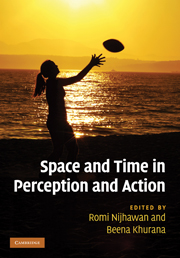Book contents
- Frontmatter
- Contents
- List of contributors
- Acknowledgments
- 1 Space and time: the fabric of thought and reality
- Part I Time–space during action: perisaccadic mislocalization and reaching
- Part II Temporal phenomena: perception
- Part III Temporal phenomena: binding and asynchrony
- Part IV Spatial phenomena: forward shift effects
- 19 The Fröhlich effect: past and present
- 20 Approaches to representational momentum: theories and models
- 21 Conceptual influence on the flash-lag effect and representational momentum
- 22 Perceptual asynchronies and the dual-channel differential latency hypothesis
- 23 Paying attention to the flash-lag effect
- 24 Illusions of time, space, and motion: flash-lag meets chopsticks and reversed phi
- 25 Bridging the gap: a model of common neural mechanisms underlying the Fröhlich effect, the flash-lag effect, and the representational momentum effect
- 26 Perceiving-the-present and a unifying theory of illusions
- 27 History and theory of flash-lag: past, present, and future
- Part V Space–time and awareness
- Index
- References
23 - Paying attention to the flash-lag effect
from Part IV - Spatial phenomena: forward shift effects
Published online by Cambridge University Press: 05 October 2010
- Frontmatter
- Contents
- List of contributors
- Acknowledgments
- 1 Space and time: the fabric of thought and reality
- Part I Time–space during action: perisaccadic mislocalization and reaching
- Part II Temporal phenomena: perception
- Part III Temporal phenomena: binding and asynchrony
- Part IV Spatial phenomena: forward shift effects
- 19 The Fröhlich effect: past and present
- 20 Approaches to representational momentum: theories and models
- 21 Conceptual influence on the flash-lag effect and representational momentum
- 22 Perceptual asynchronies and the dual-channel differential latency hypothesis
- 23 Paying attention to the flash-lag effect
- 24 Illusions of time, space, and motion: flash-lag meets chopsticks and reversed phi
- 25 Bridging the gap: a model of common neural mechanisms underlying the Fröhlich effect, the flash-lag effect, and the representational momentum effect
- 26 Perceiving-the-present and a unifying theory of illusions
- 27 History and theory of flash-lag: past, present, and future
- Part V Space–time and awareness
- Index
- References
Summary
Summary
In the flash-lag effect (FLE) a stationary flash is usually mislocalized as lagging behind a moving object in spatiotemporal alignment. Nijhawan, who postulated a mechanism of perceptual extrapolation of motion to explain the phenomenon, rediscovered this perceptual effect. The first challenge to the motion extrapolation hypothesis included an attentional shift mechanism as the alternative, which implicitly relied on the spotlight metaphor for visual attention. Other explanations have been forwarded since then, such as those based on differential latencies or perceptual postdiction. In this chapter we aim to scrutinize the role of attention in either modulating or engendering the FLE.
Introduction
To deal with even simple challenges, such as grasping an object or avoiding a collision with either stationary or moving obstacles, everyday life demands from us the ability to localize a visual stimulus, within an acceptable degree of accuracy, in both space and time. Learning how to pin down the location of an object moving along its space–time trajectory in a given task depends on the one hand on the amount and quality of perceptual information provided by the sensory system, and on the other hand on the correctness of the action generated during that task. The behavioral outcome is continuously fed back to the nervous system, therefore constraining and refining, in an adaptive way, the representation of the world both in perception and in action.
However optimized our behavior turns out to be, the underlying perceptual edifice we assemble from the available sensory world is by no means unique.
- Type
- Chapter
- Information
- Space and Time in Perception and Action , pp. 396 - 407Publisher: Cambridge University PressPrint publication year: 2010
References
- 1
- Cited by



